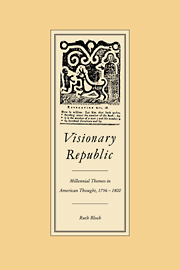Book contents
- Frontmatter
- Contents
- Acknowledgments
- Introduction
- PART I THE DEVELOPMENT OF A MILLENNIAL TRADITION IN COLONIAL AMERICA
- PART II THE RISE AND DECLINE OF MILLENNIALISM IN THE REVOLUTIONARY ERA
- 3 Whig resistance and apocalyptical Manichaeanism
- 4 The revolutionary millennialism of the 1770's
- 5 Visions of progress and ruin in the Critical Period
- PART III THE ESCHATOLOGICAL REVIVAL OF THE 1790'S
- Notes
- Index
3 - Whig resistance and apocalyptical Manichaeanism
Published online by Cambridge University Press: 29 October 2009
- Frontmatter
- Contents
- Acknowledgments
- Introduction
- PART I THE DEVELOPMENT OF A MILLENNIAL TRADITION IN COLONIAL AMERICA
- PART II THE RISE AND DECLINE OF MILLENNIALISM IN THE REVOLUTIONARY ERA
- 3 Whig resistance and apocalyptical Manichaeanism
- 4 The revolutionary millennialism of the 1770's
- 5 Visions of progress and ruin in the Critical Period
- PART III THE ESCHATOLOGICAL REVIVAL OF THE 1790'S
- Notes
- Index
Summary
The wicked plotteth against the just and gnasheth upon him with his teeth.
The Lord shall laugh at him: for he seeth that his day is coming.
Psalm 37:12, 13During the course of the revolutionary crisis the preexisting millennial tradition developed a reciprocal, dynamic relationship with secular political thought. The two came fully together only in the mid-1770's, as the patriot movement moved from resistance to revolution. Long before the full expression of revolutionary millennialism, however, an apocalyptical perspective on the struggle with Britain had already emerged. When the British government in the mid-1760's sought to impose tighter controls over America, the colonial opposition moved rapidly to interpret the emerging imperial crisis as an apocalyptical event. Eschatological imagery from the beginning intermixed with constitutional arguments, contributing a cosmic dimension to patriot political understanding. Not all patriots shared this perspective – many adhered to the measured reasoning of the law and political philosophy or else vented their emotions purely through radical whig political rhetoric. In the actual arena of public debate, however, these various outlooks did not exist in isolation, and even the more narrowly political arguments often took on an eschatological coloring. On the level of popular culture, especially, religion deeply informed political ideology.
ANTICHRISTIAN TYRANNY AND DIVINE LIBERTY
In Boston on February 14, 1766, the Sons of Liberty assembled near Liberty Tree to hear an address. Subsequently printed in Providence under the pseudonym “Pro-Patria,” it was designed to stimulate New England patriots into continued resistance against the Stamp Act.
- Type
- Chapter
- Information
- Visionary RepublicMillennial Themes in American Thought, 1756–1800, pp. 53 - 74Publisher: Cambridge University PressPrint publication year: 1985



